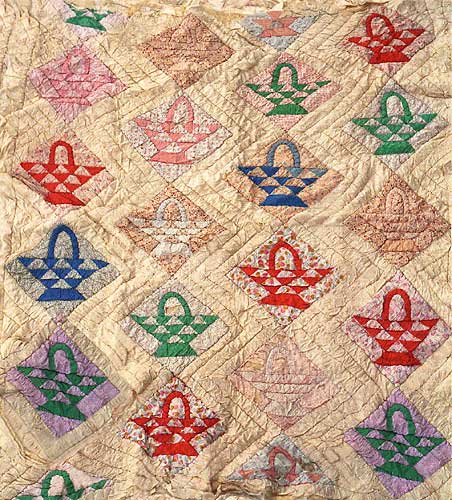 |
||
|
Mary Morgan learned to sew at a young age and was an accomplished seamstress all her life
The picture above is a photograph of an antique quilt made by Mary Morgan about 1925. |
|||
|
On the American frontier in the early days people were, and had to be extremely self sufficient. One common technique for
making quilts was to card wool into batts and then sew material (usually cotton) on each side of it. The upper, more visible
side, was then decorated by hand with personally chosen designs. The under side often was left plain. The quilt in the picture
above has a batt of raw wool more than one inch thick in the center of it.
There is a story about how this quilt came to be shown on our morganclan.com website. Mary Morgan's son James was staying with her at her house on Dove Avenue in Rigby, Idaho. One morning Mary asked James to help her clean out the garage. He agree. Since she had gotten up early and eaten breakfast, she went out to start the job while James ate breakfast. When James came out onto the back porch on his way to the garage he looked down into the garbage can. He spotted the old quilt and immediately pulled it out. Mary had started the garage cleaning early and had thrown the old quilt into the garbage. And then she had thrown more garbage into the can and there was tomato juice spilled on the quilt. James asked if he could have the quilt and she replied something to the effect of "yes you can have that old thing." Needless to say, the old quilt was cleaned and saved. Mary Morgan grew up on the farm in hard times and experienced plenty more hard times after she married and moved to another farm with Kenneth Morgan. During her life many new work saving "miracles" came into her life. Electricity. Telephones. Automobiles. In her personal life history she calls the clothes washer a miracle in her life that freed her from enormous amounts of drudgery. As a result of this process she did not like the "old" things and once they had been replaced by something newer and better, she was quick to throw the old stuff away. In her old age she had no love for antiques. They reminded her of the hard times. She liked the new things. Further comment on the old timers throwing away the old technology when the new came in. When James Morgan was living in Stevensville, Montana in the 1970's he bought a singer sewing machine that was run by a foot treadle. When he took it to the older Singer dealer in Hamilton, Montana to ask about obtaining parts, the Singer dealer told of having hauled the Singer Treadle sewing machines to the dump by the pickup load after the electric sewing machines became available. People traded in the treadle machines as fast as they could for next to nothing, and the dealer, having no use for hundreds of them, hauled them to the dump. |
|||
